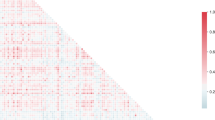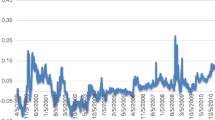Abstract
Previous research suggests that short-sellers correctly anticipate that big moves by one or more mutual funds cause temporary price distortions. By moving in the opposite direction to those trades, short-sellers outsmart mutual funds. This appears to be healthy for the overall market, but mutual funds’ vulnerability substantially reduces their profits. For informed traders, the equity lending market and the options market are substitutes for one another. In this paper, I empirically investigate how big moves of mutual funds affect the cross-section of option prices. Overall, I find strong empirical evidence for directional trading in index options. The flow-induced bearish trading activity of short-sellers is price destabilizing and greatly influences put and call option prices. Firstly, in line with the short-selling channel, inflows into mutual funds mainly impact the pricing of put options. The demand for out-of-the money put options leads to a significant drop in risk-neutral skewness. Secondly, inflows (outflows) affect the risk-neutral volatility negatively (positively); the impact on prices is consistent across put and call options. Thirdly, while the effect on risk-neutral skewness is associated with the unexpected component (based on same-day flows) only, the effect on risk-neutral volatility is associated with the unexpected and the expected component (based on prior days’ trading). Finally, while the negative relationship of inflows on risk-neutral volatility and skewness is consistent over time, the effect of outflows on risk-neutral volatility is not observable in bearish markets.


Similar content being viewed by others
Notes
I have also used other specifications for the functional form that are frequently used in the literature (replacing delta by exercise price K or moneyness K/F, where F is the forward rate, but the results are robust to these changes.
For put options, I use the corresponding call delta in the implied volatility regression.
References
Arif, S., Ben-Rephael, A., & Lee, C. M. C. (2016). Do short-sellers profit from mutual funds? Evidence from daily trades. Working Paper.
Bakshi, G., Kapadia, N., & Madan, D. (2003). Stock return characteristics, skew laws, and differential pricing of individual equity options. Review of Financial Studies, 16, 101–143.
Bams, D., Lehnert, T., & Wolff, C. (2009). Loss functions in option valuation: A framework for selection. Management Science, 55(5), 853–862.
Barone-Adesi, G., Engle, R., & Mancini, L. (2008). A GARCH option pricing model with filtered historical simulation. Review of Financial Studies, 21(3), 1223–1258.
Ben-Rephael, A., Kandel, S., & Wohl, A. (2011). The price impact of aggregate mutual fund flows. Journal of Financial and Quantitative Analysis, 46, 585–603.
Boehmer, E., Jones, C., & Zhang, X. (2008). Which shorts are informed? Journal of Finance, 63, 491–527.
Bollen, N., & Whaley, R. (2004). Does net buying pressure affect the shape of implied volatility functions? The Journal of Finance, 59(2), 711–753.
Cao, C., Chang, E. C., & Wang, Y. (2008). An empirical analysis of the dynamic relationship between mutual fund flow and market return volatility. Journal of Banking & Finance, 32, 2111–2123.
Chalmers, J. M. R., Edelen, R. M., & Kadlec, G. B. (2001). On the perils of financial intermediaries setting security prices: The mutual fund wild card option. Journal of Finance, 56, 2209–2236.
Chen, Y., & Lai, K. K. (2013). Examination on the relationship between VHSI, HSI and future realized volatility with Kalman filter. Eurasian Business Review, 3(2), 200–216.
Danis, H., Demir, E., & Bilgin, M. H. (2015). Conditional jump dynamics in stock returns: Evidence from MIST stock exchange. Singapore Economic Review, 60(1), 90–107.
Dechow, P. M., Hutton, A. P., Meulbroek, L., & Sloan, R. G. (2001). Short-sellers, fundamental analysis, and stock returns. Journal of Financial Economics, 61(1), 77–106.
Dumas, B., Fleming, J., & Whaley, R. E. (1998). Implied volatility functions: Empirical tests. The Journal of Finance, 53, 2059–2106.
Edelen, R. M., & Warner, J. B. (2001). Aggregate price effects of institutional trading: A study of mutual fund flow and market returns. Journal of Financial Economics, 59, 195–220.
Engelberg, J. E., Reed, A. V., & Ringgenberg, M. C. (2012). How are shorts informed? Short sellers, news, and information processing. Journal of Financial Economics, 105, 260–278.
Fant, L. F. (1999). Investment behavior of mutual fund shareholders: The evidence from aggregate fund flows. Journal of Financial Markets, 2, 391–402.
Figlewski, S., & Webb, G. P. (1993). Options, short sales, and market completeness. Journal of Finance, 48(2), 761–777.
Frazzini, A., & Lamont, O. (2008). Dumb money: Mutual fund flows and the cross-section of stock returns. Journal of Financial Economics, 88(2), 299–322.
Goetzman, W., & Massa, M. (2002). Daily momentum and contrarian behavior of index fund investors. Journal of Financial and Quantitative Analysis, 37(3), 375–390.
Goetzman, W., & Massa, M. (2003). Index funds and stock market growth. Journal of Business, 76(1), 1–29.
Greene, J. T., & Hodges, C. W. (2002). The dilution impact of daily fund flows on open-end funds. Journal of Financial Economics, 65, 131–158.
Lamont, O. A., & Thaler, R. H. (2003). Can the market add and subtract? Mispricing in tech stock carve-outs. Journal of Political Economy, 111, 227–268.
Lehnert, T. (2016). Mutual funds, price pressure and index options. Journal of Derivatives, 24(1), 30–46.
Lin, T., & Lu, X. (2015). How do short-sale costs affect put options trading? Evidence from separating hedging and speculative shorting demands. Review of Finance, 20(5), 1911–1943.
Lou, D. (2012). A flow-based explanation for return predictability. Review of Financial Studies, 25(1), 3457–3489.
Mishra, A. K., & Panda, S. P. (2016). Looking into the relationship between implied and realized volatility: A study on S&P CNX Nifty index option. Eurasian Economic Review, 6(1), 67–96.
Ofek, E., Richardson, M., & Whitelaw, R. F. (2004). Limited arbitrage and short sales restrictions: Evidence from the options markets. Journal of Financial Economics, 74, 305–342.
Shive, S., & Yun, H. (2013). Are mutual funds sitting ducks? Journal of Financial Economics, 107, 220–237.
Warther, V. A. (1995). Aggregate mutual fund flows and security returns. Journal of Financial Economics, 39, 209–235.
Yu, J., & Yuan, Y. (2011). Investor sentiment and the mean-variance relation. Journal of Financial Economics, 100, 367–381.
Author information
Authors and Affiliations
Corresponding author
Rights and permissions
About this article
Cite this article
Lehnert, T. Big moves of mutual funds. Eurasian Econ Rev 9, 1–27 (2019). https://doi.org/10.1007/s40822-018-0104-6
Received:
Revised:
Accepted:
Published:
Issue Date:
DOI: https://doi.org/10.1007/s40822-018-0104-6




